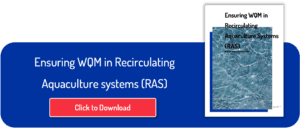
On many fish farms, several water quality parameters are only measured manually at fixed times or in selected locations. The water quality fluctuates daily and often follows rhythmic patterns. Using a traditional daily sampling method, you will often miss the peaks, meaning you can get a misleading result of the water quality.
Automatic sampling and analyses
Efficiency and Time Savings
Automated data collection enables the swift gathering of vast amounts of data. With automated tools, we can collect responses more quickly and process data in real-time. This efficiency also allows for faster decision-making, shorter research cycles, and the ability to capture time-sensitive information.
This also eliminates the need for extensive human involvement. Once the system is set up, it can operate independently, freeing up valuable human resources. Additionally, automated data collection methods can handle large-scale projects and accommodate increasing data volumes effortlessly.
Accuracy and Consistency
Automated data collection reduces the risk of human error inherent in manual methods. Mistakes in data entry, recording, or transcription can be costly and compromise the integrity of the study. Automation eliminates these errors by directly integrating data from various sources, reducing the chance of transcription mistakes, and ensuring accuracy.
This method of data collection promotes standardization across processes. We can ensure consistent data capture, design, and implement predefined questionnaires, templates, and protocols. It also makes it easier to incorporate data validation mechanisms that ensure the quality and integrity of collected data. These systems can automatically detect missing data, outliers, or inconsistencies, alerting to potential issues.
Data Analysis and Insight
Automated data collection tools often come with built-in analytical capabilities, including real-time monitoring and feedback. We can track data collection progress, identify response patterns, and adjust as needed. This enables proactive decision-making, maximizing the utility of collected data. Automated data collection can also more easily be integrated with machine learning and artificial intelligence algorithms.
Manual sampling and measurements
Although automatic sampling and analyses are beneficial, this does not mean that they are always needed or better. Some benefits of manual measurements include:
Accuracy
Manual water analyses, when conducted carefully by trained technicians, can provide highly accurate results. This accuracy is crucial for detecting contaminants and ensuring that the water upholds standards for safety and quality.
Customization
Manual water analyses can be customized to fit specific testing requirements. Different tests can be performed depending on the characteristics of the water source and the contaminants of concern.
Comprehensive Analysis
Manual water analyses can provide a comprehensive assessment of water quality. They can detect a wide range of chemical, and biological parameters as heavy metals, pathogens, and more.
Regulatory Compliance
Many regulatory agencies and standards organizations require manual water analyses to ensure compliance with safety and quality standards.
Research and Development
Manual water analyses are critical in scientific research and development. They are used to study the effects of pollutants on ecosystems, assess the efficacy of water treatment processes, and conduct environmental impact assessments.
Problem Solving
Manual water analyses are essential when troubleshooting water quality issues. By identifying specific contaminants or imbalances, they can guide the development of effective solutions and treatment strategies. When doing manual analyses and sampling the human eye and other organs/sensors can detect errors that automatic system cannot.
Education and Awareness
Manual water analyses can serve as educational tools to raise awareness about water quality and environmental issues. They help individuals and communities understand the importance of clean and safe water.
Example of automatic versus manual collection
This is an example of a worst-case comparison of manual vs. automated collection.
Figure 1 presents data from a fish farm measured with an automatic system. Here, the CO2-concentrations are measured six times a day in each tank, which provides a realistic picture of the current water quality.

Figure 1
Figure 2 presents data from the same farm, but only with daily measurements (marked as red crosses on Figure 1). This simulates an example of a fish farm performing manual measurements every morning. At first sight, Figure 2 seems to represent a tank with a stable water quality and a reasonable CO2-level. However, since the measurements are only done once every morning when the CO2-concentrations are low, it creates a misleading picture.

Figure 2
Oppositely, Figure 1 displays fluctuations with daily peaks and shows how the CO2-concentrations often exceeds preferable levels. This instability is not captured by manual measurements. Additionally, the automatic collection saves you the effort of having to manually keep track of the values.
This comparison reveals why it is important to measure and monitor the water quality consistently. High and fluctuating CO2-levels reduce the fish’s growth and feed conversion rate. But these patterns are hard to identify with few, manual measurements, which causes decisions to be made based on inadequate information. We are not able to identify and solve the problem without enough data, which can lead to too low pH and uncontrolled levels of free CO2.
To summarize
Automated data collection offers significant advantages over manual methods, including improved efficiency, accuracy, scalability, and analytical capabilities. By reducing the risks of human error, ensuring data standardization, and facilitating advanced analysis, automation enhances the reliability of collected data. However, it is vital to create a balance between automation and human involvement, as certain analyses still require the insights and adaptability that can only be provided by manual data collection methods.
